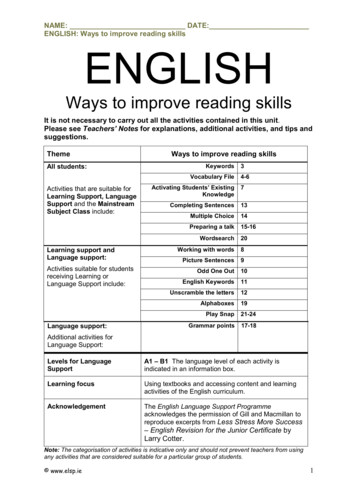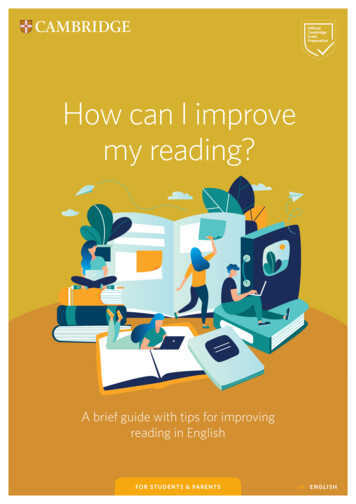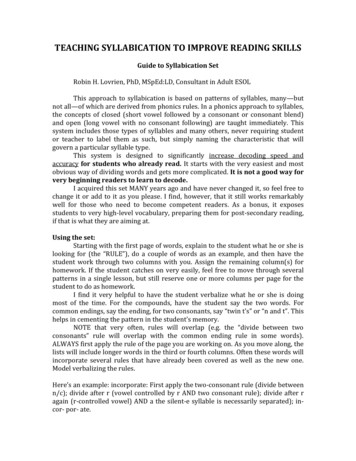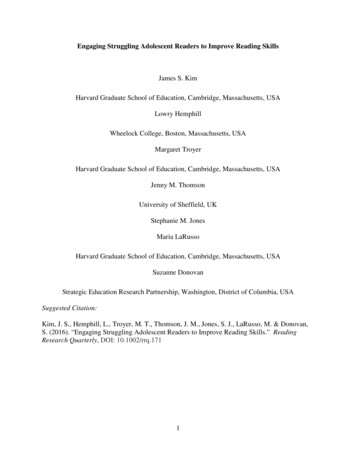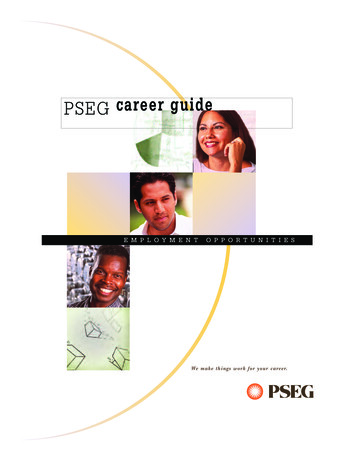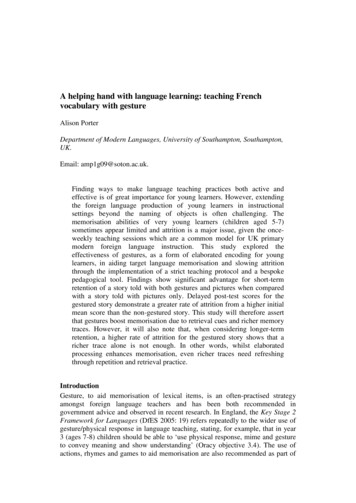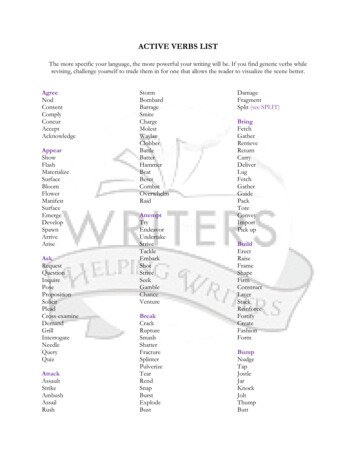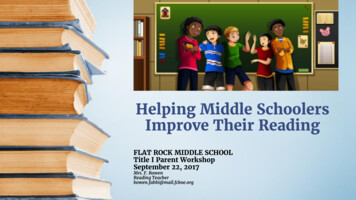
Transcription
Helping Middle SchoolersImprove Their ReadingFLAT ROCK MIDDLE SCHOOLTitle I Parent WorkshopSeptember 22, 2017Mrs. F. BowenReading Teacherbowen.fabbi@mail.fcboe.org
Three components of readingmiddle schoolers can improve:Vocabulary: the words students must know to communicate andread effectivelyFluency: the capacity to read text accurately, quickly, andsmoothlyComprehension: the ability to understand and gain meaningfrom what has been read
Why is it important to help middleschoolers improve their readingskills?*Middle schoolers need strong vocabulary and reading comprehension skills toperform well on state assessments, such as the GMAS.*Reading is an important avenue for learning new material and gatheringinformation.*Thinking ahead.The SAT / ACT, the exams the colleges and universities look at todetermine whether the students can succeed in their post-secondary education, hasreading comprehension sections and a writing section.*Have strong reading skills is critical for success in school now, in most careers, andin life.
What can parents/guardians do?Help increase vocabulary.Increase Conversation-TimeTurn off the TV and electronic devices; talk about current events and other interests.Make an effort to use more complex language in your conversations as your childgrows and matures.Play Word GamesGames such as Scrabble, Boggle, Upwords, and Scattergories are fun and will helpyour middle schooler learn new vocabulary words.Visit The Library OftenPublic libraries are great resources for books; ask the librarian for suggestions ontitles that reflect your child’s reading level and interest. Make visiting the librarypart of your family's routine.
Help improve reading fluency.Model fluent reading. Choose a section of a book, magazine, or newspaper then readit effortlessly and smoothly with expression.Try “Repeated Reading.” Read a passage then ask your middle schooler to repeat thereading. Another option is for the adult to record his or her voice as they read thepassage then tape the youth’s voice reading the same material. Play back the tapesto note the difference between the readings.Engage in “Choral Reading.” In this strategy, the adult and the adolescent read thepassage at the same time, then discuss the problem areas of text.Try “Echo Reading.” Reading a line or sentence from a book, then have theadolescent read the same line, trying to mimic the adult’s expression and fluency.
Support the development of readingcomprehension skills.Ask middle schoolers for their opinions about what they are reading and/or aboutthe author. Parents should talk about what they are reading with adolescents.Read the books that students are assigned for school. That way, you can discuss thebooks and check for comprehension.Listen to books on CD’s in the car or as a family at home. Talk about the stories.After clipping articles for your middle schooler, follow up with questions such as,What did you think of the article I gave you?” This is practice in talking about whathas been read.Take reading materials with you on outings. Encourage your middle schooler to readwhile riding in the car , waiting at doctor’s office, passing time between activities.
Reading Strategies (Continued)Sticky-Note DiscussionsThis works effectively after your child has read a selection,he/she uses sticky notes to mark the places he/she wants to talkabout.Read-and-Say-SomethingThis works effectively for difficult materials. Rather than havingyour child struggles alone with the meaning, have a discussionabout the information contained in the text.Authentic QuestionsAsk your child to read or listen, record questions about thematerial he/she does not understand.
Reading Strategies (Continued)Jump-In ReadingEnjoy reading a story with family members by allowing each personto read a portion of the story. This technique motivates your child toread a longer text.Selective Underlining/HighlightingHelps your child understands the story’s main idea and for organizinginformation from selections.Think-Pair-ShareDiscussion strategy that helps ensure every member of the familybecomes an active participant. It works well as a problem-solvingstrategy or as a break in a lecture.
Reading Strategies (Continued)Seed DiscussionsHelps your child lead his/her own discussion by writingdown one important thing about what he/she is reading.Know-Want to Know-Learned: (KWL)It involves three overlapping events: your child brainstormswhat he/she knows about a topic of discussion or story, recordswhat he/she wants to know, and then list what he/she actuallylearned.Pre and Post-Reading Journal EntriesYour child writes about what he/she knows before reading andthen writes what he/she learned from his/her reading.
Reading Strategies (Continued)Two-Column Notes: Main Idea and DetailsHelps your child organize main ideas and details fromreading assignments.Problem-Solution NotesThis is organized so that your child creates chart with two (2)columns, lists the following four (4) questions in the left-handcolumn:1. What is the problem?2. What are the causes of the problem?3. What are the effects of the problem?4. What are the solutions to the problem?Then, your child answers the aforementioned questions in the rightcolumn of the chart.
Reading Strategies (Continued)Dialogue LogsAfter all members of the family write about a particular topic/story,trade logs and comment back to each person response/information.This makes learning more social, and writers get a response rightaway.Perspective EntriesYour child can take on the role of characters, animals, orfamous people. This helps your child empathize with a character’sfeelings and problems.Literacy ElementsAs your child reads a story, he/she can use sticky notes to recordinformation in his/her journal about the character, setting, andproblems. Then, you can have a discussion on the informationgathered as result of this process.
Remember Rule #1!Make sure your middle schooler reads, reads, reads and readssome more EVERY DAY!
Reading Online Resources for ParentsHelping Your Child Become a Reader - U.S. Department of /reader/index.htmlReading Tips for Parents - Florida Department of 539/urlt/Parent-Tips.pdfReading at Home: 10 Simple Strategies for g Tips for readingtips/readingtips.pdfReading Tips for Parents (in 11 ading-tips-parents-11-languagesScholastic’s Reading Tips for ts
Reading Online Resources for Parents(Continued)Reading Tips for Parents - Florida Department of 539/urlt/Parent-Tips.pdfStrategies Packet for Parents and Students for Improving Reading, Writing and S Inst Strat.pdfReading Tips for Parents of Middle School g%20Tips%20for%20Parents.pdfTips for Helping Children with Reading Comprehension /pdf/136 Reading Comprehension Difficulties.pdfReading Comprehension Tips for ding-comprehension-tips-for-parents.pdfA Parent’s Little Guide to Helping Children ts/parents-little-guide.pdf
*Middle schoolers need strong vocabulary and reading comprehension skills to perform well on state assessments, such as the GMAS. *Reading is an

